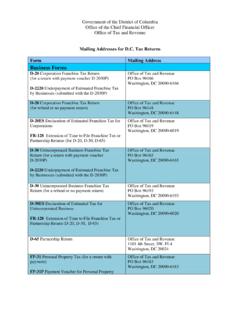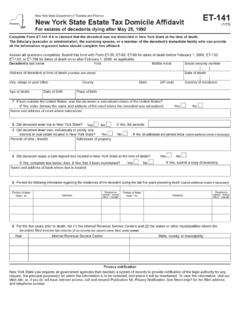Transcription of The Estate Tax: Ninety Years and Counting
1 The Estate Tax: Ninety Years and Counting by Darien B. Jacobson, Brian G. Raub, and Barry W. Johnson F. or the past 90 Years and at key points through- wealth held by the living population. These wealth out American history, the Federal Government estimates are produced from Estate tax data using the has relied on Estate and inheritance taxes as Estate multiplier technique and are an important tool sources of funding. Proponents have frequently for studying the macroeconomy, as well as a advocated that these taxes are effective tools for pre- valuable supplement to information collected through venting the concentration of wealth in the hands of surveys, which frequently underrepresent the very a relatively few powerful families, while opponents SOI first published estimates of personal believe that transfer taxes discourage capital accumu- wealth derived from Estate tax data for 1962, follow- lation, curbing national economic growth.
2 This ten- ing in the footsteps of scholars like Horst Mender- sion, along with fiscal and other considerations, has shausen and Robert Lampman, who had published led to periodic revisions of Federal Estate tax laws, similar estimates for earlier decades using SOI tabu- affecting both the size of the decedent population lated data. SOI Estate tax data have also been used to subject to the tax and the revenue collected. study the transmission of wealth between generations, and, combined with data from income tax returns The Statistics of Income Division's Estate Tax filed by decedents prior to death, to derive measures Studies of economic well-being. The Statistics of Income Division (SOI) and its pre- decessor organizations have compiled statistics on Historical Overview estates that file Federal Estate tax returns since the in- The term death tax has been used to describe a vari- ception of the tax in 1916.
3 These data have been in- ety of different taxes related to the power to transmit strumental in both administering the tax and forming or the transmission or receipt of property by death. 2. a better understanding of the financial arrangements Stamp taxes or duties, are taxes on the recordation of employed by the nation's wealthiest individuals. legal documents such as wills. Estate taxes are excise Data from Estate tax returns are regularly used taxes on the privilege of transferring property at death to estimate annual revenues and to project future re- and are usually graduated based on the size of the ceipts. These data have also been used to support the decedent's entire Estate . An inheritance or legacy tax analysis and debates that occurred in crafting the tax is an excise tax levied on the privilege of receiving law changes chronicled in this paper.
4 In this context, property from the decedent. These taxes are usually Estate tax data have frequently been used to evalu- graduated based on the amount of property received ate the effects of the tax laws on the economic and by each beneficiary and on each beneficiary's rela- social behavior of the very wealthy. For example, tionship to the the effects of Estate taxation on the longevity of busi- Taxation of property transfers at death can be nesses and farms, as well as the effects of the tax on traced back to ancient Egypt as early as 700 a decedent's propensity to make charitable bequests, Nearly 2,000 Years ago, Roman Emperor Caesar Au- have been important considerations to policymakers gustus imposed the Vicesina Hereditatium, a tax on when debating changes in Estate tax laws. successions and legacies to all but close In addition to using Estate tax data directly for Taxes imposed at the death of a family member were tax policy administration, these data have formed quite common in feudal Europe, often amounting to the foundation for periodic estimates of personal a family's annual property rent.
5 By the 18th century, stamp duties and registration fees on wills, invento- Darien B. Jacobson and Brian G. Raub are economists ries, and other documents related to property transfers with the Special Studies Special Projects Section. Barry W. at death had been adopted by many nations, including Johnson is Chief of the Special Projects Section. that of the newly formed United States of America. 1 For more detail on using the Estate multiplier technique to estimate wealth, see: Johnson, B. and L. Woodburn (1993), Estate Multiplier Technique, Recent Improvements for 1989, Compendium of Federal Estate Tax and Personal Wealth Studies, 391-400, Statistics of Income Division. 2 Silberstein, Debra Rahmin, (2003) A History of the Death Tax A Source of Revenue or Vehicle for Wealth Redistribution, Brandeis Graduate Journal, Vol. 1, Issue 1.
6 , p. 1. 3 Bittker, Boris I, Elias Clark, and Grayson McCouch (2005) Federal Estate and Gift Taxation, 9th Ed., Thompson/ West, St. Paul, MN p. 9. 4 Paul, Randolph E. (1954), Taxation in the United States, Little, Brown, and Company, Boston, MA. 118 5 Smith, Adam (1913), An Inquiry into the Nature and Causes of the Wealth of Nations, Dutton, New York. The Estate Tax: Ninety Years and Counting The Stamp Tax of 1797 Figure A. In 1797, the Congress chose a system of stamp 1864 Death Tax Rates duties as a source of revenue in order to raise funds Rate on Rate on for a Navy to defend the nation's interests in re- Relationship property legacies sponse to an undeclared war with France that had be- (percent) (percent). gun in 1794. Federal stamps were required on wills Lineal descendents, offered for probate, as well as on inventories and letters of administration.
7 Stamps also were required Descendants of Uncle, aunt, and their on receipts and discharges from legacies and intestate Great uncle, aunt, and their distributions of Taxes were levied as fol- Other relatives, unrelated lows: 10 cents on the inventories of the effects of de- ceased persons, and 50 cents on the probate of wills and letters of administration. The tax on the receipt of legacies was levied on bequests larger than $50, such The stamp tax was graduated and ranged from which widows (but not widowers), children, from 50 cents on estates valued at less than $2,500. and grandchildren were exempt. Bequests between to $20 on estates valued from $100,000 to $150,000, $50 and $100 were taxed 25 cents; those between with an additional $10 assessed on each $50,000 or $100 and $500 were taxed 50 cents; and an addition- fraction thereof over $150,000.
8 Al $1 was added for each subsequent $500 bequest. By 1864, the mounting cost of the Civil War led In 1802, the crisis ended, and the tax was to the reenactment of the 1862 Act, with some modi- These changes included the addition of a The Revenue Act of 1862 succession tax a tax on bequests of real Estate and In the Years immediately preceding the American an increase in legacy tax rates (Figure A). In ad- Civil War, revenue from tariffs and the sale of public dition, the tax was applied to any transfers of real lands provided the bulk of the Federal budget. The Estate made during the decedent's life for less than advent of the Civil War again forced the Federal adequate consideration, except for wedding gifts, Government to seek additional sources of revenue, thus establishing the nation's first gift tax. Transfers and a Federal death tax was included in the Revenue of real Estate to charities, were taxed at the highest Act of 1862 (12 Stat.)
9 432). However, the 1862 tax rates. Bequests to widows, but not widowers, were differed from its predecessor, the stamp tax of 1797, exempt from the succession tax, as were bequests of in that the 1862 tax package included a legacy or less than $1,000 to minor children. The end of the inheritance tax in addition to a stamp tax on the pro- Civil War, and subsequent discharge of the debts as- bate of wills and letters of administration. Original- sociated with the war, gradually eliminated the need ly, the legacy tax only applied to personal property, for extra revenue provided by the 1864 Act. There- and tax rates were graduated based on the legatee's fore, in 1870, the legacy and succession taxes were relationship to the decedent, not on the value of the The stamp tax was repealed in bequest or size of the Estate . Rates ranged from Between 1863 and 1871, these taxes had contributed percent on bequests to ancestors, lineal descendants, a total of about $ million to the Federal budget.
10 And siblings to 5 percent on bequests to distant rela- tives and those not related to the decedent. Estates The War Revenue Act of 1898. of less than $1,000 were exempted, as were bequests Throughout the last half of the 19th century, the in- to the surviving spouse. Bequests to charities were dustrial revolution brought about profound changes taxed at the 5-percent rate, despite pleas from many in the economy. Industry replaced agriculture in Congress that the tax should be used to encourage as the primary source of wealth and political power 6 Stamp Act of 1797, 1 Stat. 527. 7 Zaritsky, H. and T. Ripy (1984), Federal Estate , Gift, and Generation Skipping Taxes: A Legislative History and Description of Current Law, Report No. 84-156A. 8 Office of Tax Analysis (1963), Legislative History of Death Taxes in the United States, unpublished manuscript.
















